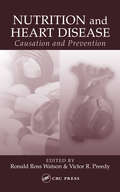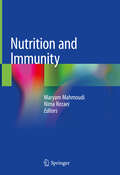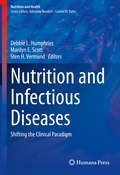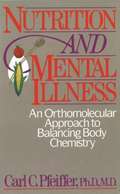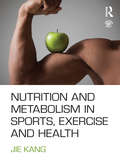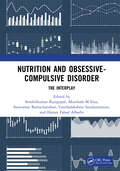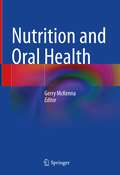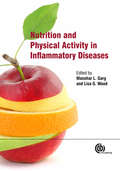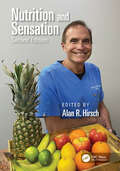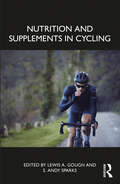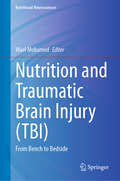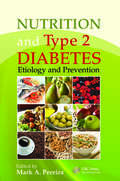- Table View
- List View
Nutrition and Health in a Developing World
by Martin W. Bloem Saskia De Pee Douglas TarenThis third edition reviews the epidemiology, policies, programs and outcome indicators that are used to determine improvements in nutrition and health that lead to development. This greatly expanded third edition provides policy makers, nutritionists, students, scientists, and professionals with the most recent and up-to-date knowledge regarding major health and nutritional problems in developing countries. Policies and programs that address the social and economic determinants of nutrition and health are now gaining in importance as methods to improve the status of the most vulnerable people in the world. This volume provides the most current research and strategies so that policy makers, program managers, researchers and students have knowledge and resources that they can use to advance methods for improving the public's health and the development of nations. The third edition of Nutrition and Health in Developing Countries takes on a new context where the word "developing" is now a verb and not an adjective.
Nutrition and Heart Disease: Causation and Prevention
by Victor R. Preedy Ronald Ross WatsonHeart disease is the primary cause of death and disability in Western countries. Research indicates that nutrition and diet play key roles in both preventing and causing many types of heart damage and dysfunction. By understanding the complex relationship between diet and disease, new prevention measures can be established and millions of lives can
Nutrition and Hydration in Hospice Care: Needs, Strategies, Ethics (The\hospice Journal #Vol. 9, Nos. 2/3)
by Charlette Gallagher-Allred Madalon O'Rawe AmentaThis scholarly book enables health care professionals to appropriately address hospice patients’and families’concerns about nutrition and hydration. Nutrition and Hydration in Hospice Care is a comprehensive resource that provides hands-on practical information that readers can use in everyday hospice practice. The chapters identify problems, solutions, and ethical issues of nutrition and hydration in hospice care.The contributing authors provide the way for health care professionals, especially those in nursing, dietary, and pharmacy units, to jointly and effectively manage troublesome symptoms and ethical issues. The following topics are included in the scope of coverage: nutrition/hydration needs during end-stage disease nursing and dietary roles in identifying nutrition/hydration problems and implementing treatment how needs of dying children and adults are different legal and ethical dilemmas of withholding or withdrawing nutrition and hydration appropriate and inappropriate uses of enteral and parenteral nutrition support during end-stage diseases food service considerations in inpatient hospice facilities appetite stimulant use in palliative careBecause Nutrition and Hydration in Hospice Care is comprehensive, all members of hospice staffs can find practical information to use each day. The authors cover issues not found in other books for nurses, dietitians, pharmacists, and physicians. They will find the information ready to apply at their work settings.
Nutrition and Immunity
by Nima Rezaei Maryam MahmoudiThis volume provides readers with a systematic assessment of current literature on the link between nutrition and immunity. Chapters cover immunonutrition topics such as child development, cancer, aging, allergic asthma, food intolerance, obesity, and chronic critical illness. It also presents a thorough review of microflora of the gut and the essential role it plays in regulating the balance between immune tolerance and inflammation. Written by experts in the field, Nutrition and Immunity helps readers to further understand the importance of healthy dietary patterns in relation to providing immunity against disorders and offering readily available immunonutritional programming in clinical care. It will be a valuable resource for dietitians, immunologists, endocrinologists and other healthcare professionals.
Nutrition and Infectious Diseases: Shifting the Clinical Paradigm (Nutrition and Health)
by Sten H. Vermund Debbie L. Humphries Marilyn E. ScottThis comprehensive and user-friendly volume focuses on the intersection between the fields of nutrition and infectious disease. It highlights the importance of nutritional status in infectious disease outcomes, and the need to recognize the role that nutrition plays in altering the risk of exposure and susceptibility to infection, the severity of the disease, and the effectiveness of treatment. Split into four parts, section one begins with a conceptual model linking nutritional status and infectious diseases, followed by primers on nutrition and immune function, that can serve as resources for students, researchers and practitioners. Section two provides accessible overviews of major categories of pathogens and is intended to be used as antecedents of pathogen-focused subsequent chapters, as well as to serve as discrete educational resources for students, researchers, and practitioners. The third section includes five in-depth case studies on specific infectious diseases where nutrition-infection interactions have been extensively explored: diarrheal and enteric disease, HIV and tuberculosis, arboviruses, malaria, and soil-transmitted helminths. The final section addresses cross-cutting topics such as drug-nutrient interactions, co-infections, and nutrition, infection, and climate change and then concludes by consolidating relevant clinical and public health approaches to addressing infection in the context of nutrition, and thus providing a sharp focus on the clinical relevance of the intersection between nutrition and infectionWritten by experts in the field, Nutrition and Infectious Diseases will be a go to resource and guide for immunologists, clinical pathologists, sociologists, epidemiologists, nutritionists, and all health care professionals managing and treating patients with infectious diseases.
Nutrition and Integrative Medicine for Clinicians: Volume Two
by Aruna BakhruMystery illness can be helped, and this book lays the groundwork for it! Can a water-damaged building ruin your health and cause debilitating exhaustion, chronic pain, insomnia, anxiety, obesity and "brain fog?" Could a flood or wet basement make you sick even if it has long dried out? Building on its predecessor, Nutrition and Integrative Medicine for Clinicians: Volume Two is an essential, peer-reviewed resource for practitioners to help patients with various illnesses found in society, including those contracted from water-damaged structures, that can lay the groundwork for a healthy road to recovery. Written by authors at the forefront of their respective fields, this book presents information for people "written off" as having a "mystery illness," fibromyalgia or chronic fatigue. Chronic inflammatory response syndrome (CIRS) is ubiquitous and affects many body systems, yet it is largely unrecognized by doctors, who misdiagnose CIRS patients daily. This book is a comprehensive guide on evaluating illnesses that are difficult to diagnose, including CIRS. This volume contains information on various subjects, including: Illnesses resulting from water-damaged buildings and subsequent change in the microbiome of the building. Steps to heal from mold/mycotoxin illnesses. Legal and ethical considerations in health issues from exposure to a water-damaged building as well as introducing the "building science" to clinicians. Effects of CIRS on metabolism and insulin resistance. Environmental hormone disruptors. Myalgic encephalitis/chronic fatigue syndrome. Regenerative agriculture. Pediatric sleep-related breathing disorders and their effects on growth and development. Circadian effects of artificial light and their effects on mitochondria. Nutritional support in Covid. The design nature of sound and its relationship to neural networks. The human body as a biological sound healing instrument. The use of color in clinical application. Art in medicine. Living life with intentionality and mindfulness. Making childbirth a positive experience.
Nutrition and Integrative Medicine: A Primer for Clinicians
by Aruna BakhruWhile medical professionals continue to practice traditional allopathic medicine, the public has turned toward nutritional and integrative medical therapies, especially for addressing the proliferation of chronic diseases. Written by leaders in the academic and scientific world, Nutrition and Integrative Medicine: A Primer for Clinicians presents various modalities to help restore health. This book provides users with a guide to evaluating and recommending nutritional and integrative therapies. The book offers insights on the microbiome of the human body, examines the relationship of human health to the microbiome of the food we ingest, and introduces the concept of "food as information." It provides enlightenment on anti-aging and healing modalities, mind–body medicine, and an investigation of psychological trauma as related to disease causation. Integrative therapies, including water, light, and sound therapy, are explored, and information on healing chronic disease through nutrition, the tooth–body connection, the role of toxins in disease causation, and electromagnetic field hypersensitivity, as well as its management, is presented.
Nutrition and Mental Health
by Ruth Leyse-WallaceAn examination of the role nutrients play in mental health, this book reviews the scientific literature from many fields of science: health, psychology, nutrition, mental well-being, and the interface with chronic disease. The book provides a straightforward, readable report of broadly selected scientific research on how various nutrients affect mental health. It covers several types of mental health disorders and their links to nutrients, nutritional status, and nutritional supplements. This book provides mental health professionals with the information they need to evaluate nutritional issues.
Nutrition and Mental Illness: An Orthomollecular Approach to Balancing Body Chemistry
by Carl C. PfeifferNutritional therapy for mental illness. Explains the role played by vitamins and trace elements in mental health.
Nutrition and Metabolism
by Christos S. MantzorosNutrition and Metabolism: Underlying Mechanisms and Clinical Consequences brings together internationally recognized experts to comprehensively review our current understanding of how nutrition interacts with the genetic substrate as well as environmental-exogenous factors, including physical activity or the lack thereof, to result in insulin resistance and the metabolic syndrome. After presenting the scope of the problem, the first major part of the book is devoted to genetics and pathophysiology, the second part of the book presents the public health perspective of the most prevalent problems associated with nutrition and the metabolic syndrome, whereas the third major part of the book focuses on clinical assessment and management of the main disease states associated with inappropriate nutrition and the metabolic syndrome. Finally, general information useful for both clinicians and researchers alike is presented in the Appendix. Nutrition and Metabolism: Underlying Mechanisms and Clinical Consequences offers the reader an up-to-date and authoritative review of the major scientific and clinical aspects of the overlapping areas between nutrition and metabolism.
Nutrition and Metabolism (The Nutrition Society Textbook #5)
by Ian A Macdonald Susan A Lanham-New Helen M RocheNutrition and Metabolism Second Edition Edited by Susan A Lanham-New, Ian A Macdonald and Helen M Roche EditionIn this second edition of the second title in the acclaimed Nutrition Society Textbook Series, Nutrition and Metabolism has been revised and updated to meet the needs of the contemporary student. Groundbreaking in their scope and approach, the titles in the series: Provide students with the required scientific basics of nutrition in the context of a systems and health approach Enable teachers and students to explore the core principles of nutrition, to apply these throughout their training, and to foster critical thinking at all times. Throughout, key areas of knowledge are identified Are fully peer-reviewed, to ensure completeness and clarity of content, as well as to ensure that each book takes a global perspective Nutrition and Metabolism is an essential purchase for students of nutrition and dietetics, and also for those students who major in other subjects that have a nutrition component, such as food science, medicine, pharmacy and nursing. Professionals in nutrition, dietetics, food science, medicine, health sciences and many related areas will also find much of great value within its covers.
Nutrition and Metabolism (The Nutrition Society Textbook)
by Ian A. Macdonald Helen M. Roche Susan A. Lanham-New Annemie M.W.J. ScholsComprehensive resource on all aspects of nutrition and metabolism; covering vitamin and mineral deficiencies, diseases, immunity, brain and bone health, and more. Now in its third edition, Nutrition and Metabolism has been updated throughout to present readers with the core principles of nutrition in the context of a systems and health approach. Written by a team of internationally renowned experts, the text includes information on: Body composition, energy metabolism, proteins, amino acids, carbohydrates, lipids, vitamins, minerals, trace elements, food intake, and food composition Energy, macronutrients, pregnancy and lactation, growth and aging, brain nutrition, sensory systems and food palatability, the gastrointestinal system, and the cardiovascular system Societal food choices, over- and undernutrition, eating disorders, dieting, foetal programming, cancer, osteoporosis, and diabetes How nutrition affects the liver, pancreas, kidney, lungs, heart and blood vessels, and how nutrition relates to the development of traumatic, infectious, and malignant diseases Nutrition and Metabolism is an essential resource for students and practitioners of nutrition and dietetics, as well as students majoring in other subjects that have a nutrition component.
Nutrition and Metabolism in Sports, Exercise and Health
by Jie KangA key determinant of successful athletic performance is the high-level energy transformation which begins with combustion of the food that we eat. By developing a sound understanding of good nutrition we can improve athletic performance, help maintain good health and prevent disease. This clear and comprehensive introduction to nutrition in sport, exercise and health goes further than any other textbook in integrating key nutritional facts, concepts and dietary guidelines with a thorough discussion of the fundamental biological science underpinning our physiological and metabolic processes. By clearly explaining how nutrients function within our biological system, the book helps students to develop a better understanding of the underlying mechanisms, which, in turn, will help the student to apply their knowledge in practice. The book includes in depth discussion of key contemporary topics within nutrition including: nutrient bioenergetics nutrition and metabolic disease nutritional ergogenic aids nutrition for special populations nutritional assessment. Each chapter includes useful pedagogical features, including case studies, review questions, definitions of key terms, and practical laboratory exercises – such as techniques for assessing nutritional status, body composition and physical activity patterns. A companion website offers additional teaching and learning features, such as PowerPoint slides, multiple-choice question banks and web links. As the most up-to-date introduction to sport and exercise nutrition currently available, this book is essential reading for all students of sport and exercise science, kinesiology, physical therapy, nutrition, dietetics or health sciences. Visit the companion website at www.routledge.com/cw/kang
Nutrition and Metabolism in Sports, Exercise and Health
by Jie KangThe second edition of Nutrition and Metabolism in Sports, Exercise and Health offers a clear and comprehensive introduction to sport and exercise nutrition, integrating key nutritional facts, concepts and dietary guidelines with a thorough discussion of the fundamental biological science underpinning physiological and metabolic processes. Informed by the latest research in this fast-moving discipline, the book includes brand-new sections on, amongst others: • Cellular structure for metabolism • Alcohol and metabolism • Uncoupling protein and thermogenesis • Dietary guidelines from around the world • Nutrient timing • Protein synthesis and muscle hypertrophy • Protein supplementation • Ergogenic effects of selected stimulants • Nutritional considerations for special populations • Dehydration and exercise performance Each chapter includes updated pedagogical features, including definitions of key terms, chapter summaries, case studies, review questions and suggested readings. A revised and expanded companion website offers additional teaching and learning features, such as PowerPoint slides, multiple-choice question banks and web links. No book goes further in explaining how nutrients function within our biological system, helping students to develop a better understanding of the underlying mechanisms and offering the best grounding in applying knowledge to practice in both improving athletic performance and preventing disease. As such, Nutrition and Metabolism in Sports, Exercise and Health is essential reading for all students of sport and exercise science, kinesiology, physical therapy, strength and conditioning, nutrition or health sciences.
Nutrition and Metabolism of Dogs and Cats (Advances in Experimental Medicine and Biology #1446)
by Guoyao WuThis book provides new knowledge about the nutrition and metabolism, as well as the roles of nutrients in the immunity, health, and management of companion animals (dogs and cats). The domestic dog (facultative carnivore) and the domestic cat (obligate carnivore) have evolved differentially in their digestive tract, nutrition, metabolism, chemical sensing, and feeding behavior. These animals have been human companions for at least 12,000 and 9,000 years, respectively, and continue to contribute to the mental health and well-being of children, adolescents, and adults. Both dogs and cats have become increasingly popular in many countries and worldwide over the past decades. Comprehensive update about how the animals utilize dietary nutrients for optimum growth, development, and health is beneficial for their owners, as well as students and researchers. Chapter 4: Characteristics of Nutrition and Metabolism in Dogs and Cats is available open access under a Creative Commons Attribution 4.0 International License
Nutrition and Obsessive-Compulsive Disorder: The Interplay
by Senthilkumar Rajagopal Saravanan Ramachandran Geethalakshmi Sundararaman Hanan Fahad Alharbi Musthafa M EssaKey features – Covers emerging therapeutic and nutritional approaches for the treatment and management of OCD Reviews the role of various micro-nutrients in OCD Discusses the prenatal genetic diagnosis and application of computational modelling in OCD Includes the nutritional and dietary roles in neuropsychiatric disorders like depression and obsessive-compulsive disorder (OCD) Explores the application of nano-biotechnology in OCD
Nutrition and Oral Health
by Gerry McKennaThis book explores in depth the relationships between nutrition and oral health. Oral health is an integral part of general health across the life course, and this book examines nutritional and oral health considerations from childhood through to old age, with particular attention focused on the consequences of demographic changes. Current knowledge on the consequences of poor diet for the development and integrity of the oral cavity, tooth loss, and the progression of oral diseases is thoroughly reviewed. Likewise, the importance of maintenance of a disease-free and functional dentition for nutritional well-being at all stages of life is explained. Evidence regarding the impact of oral rehabilitation on nutritional status is evaluated, and strategies for changing dietary behaviour in order to promote oral health are described. Nutrition and Oral Health will be an ideal source of information for all who are seeking a clearly written update on the subject.
Nutrition and Performance in Masters Athletes
by Peter R.J. ReaburnAddresses the Aging Process and Its Effect on Sports PerformanceAge-related changes influence all physiological systems, including those used during exercise and sport. Highlighting masters athletes-older adults who train and compete in organized sports-Nutrition and Performance in Masters Athletes examines the extent to which regular physical trai
Nutrition and Physical Activity in Inflammatory Diseases
by Anne Marie Minihane Lisa Wood Rohan Walker Josep Bassaganya-Riera Sridevi Devaraj Jeff Coombes Philip Calder Robert Mcnamara Catherine Field Manohar Garg Lynnette Ferguson Marlena Kruger Andreia Oliveira Monica Bullo David Heber Samir Samman Elizabeth Kovacs Goran Paulsen Mohsen Meydani Caryl Nowson Anette Buyken Burno PotCertain nutrients and physical activity can significantly alter immune function and inflammation. Targeted interventions may be an effective and inexpensive means to improve the inflammation and immune dysfunction associated with chronic diseases. This book defines the relevant underlying biological mechanisms and strengthens our understanding of how nutrients and physical activity impact inflammatory diseases. A useful reference for researchers and students of nutrition, physiology and sports science, it explores the unique aspects of inflammation induced by nutritional deficiencies or activity levels, and their interrelationship.
Nutrition and Psychiatric Disorders: An Evidence-Based Approach to Understanding the Diet-Brain Connection (Nutritional Neurosciences)
by Firas Kobeissy Wael MohamedThe book explores the intricate relationship between nutrition, brain function, and psychiatric disorders. The first section of the book delves into the neurobiological aspects of psychiatric disorders, including the neuroanatomy, neuropathology, biochemical and neuropharmacology factors that play a role in the development of these disorders. It also discusses the impact of human nutrition on brain function and the implications of nutrition and metabolism on psychological functioning. The next section focuses on the diet-brain connection, exploring nutritional psychiatry and the current state of evidence, the role of the microbiome, and the effects of certain foods such as chocolate and coffee on mood and mood disorders. The chapters also examine the impact of diet on mental health and cognition across the lifespan and provides a case study of the relationship between diet and psychological health. In the final section, the book delves into the nutritional treatment of psychiatric disorders, including the psychopharmacology of psychiatric disorders and food intake, and multidisciplinary approaches to psychiatric treatment.. Overall, this book offers a comprehensive and evidence-based examination of the complex relationship between nutrition, brain function, and psychiatric disorders, and provides a foundation for further research and development of effective nutritional interventions for the treatment of these disorders.
Nutrition and Sensation
by Alan R. HirschNutrition and Sensation, Second Edition continues to explore how sensations unravel the hidden sensory universe which acts to control our appetite and nutritional desires. The sensory influence on food is found everywhere – whether it is the color of soda, the viscosity of maple syrup, or the aroma of chocolate – the sensory experience fuels consumption. This book continues to discuss the impact of olfaction, gustation, retronasal olfaction, vision, vestibular function, hearing, and somatosensory and tactile nature on nutrition. It also focuses on the use of the sensory system to treat nutritional disorders including obesity, with attention to the mechanisms encompassing smell and taste and how this can influence satiety and weight. Nutrition and Sensation, Second Edition provides a deeper understanding of the fascinating link between the sensory system and nutrition.
Nutrition and Stroke: Current State and Future Perspectives (Nutritional Neurosciences)
by Wael Mohamed Mohd Basri Mat-NorThis book provides a thorough examination of the correlation between nutrition and stroke. It delves into the interplay between nutrition and brain functions, neurogenesis, and cognitive functions. Additionally, it investigates how various types of nutrition relate to stroke. Moreover, it discusses recent progress in recognizing the significant therapeutic role of different nutrients in addressing stroke. Finally, it offers an overview of nutrients as neuroprotective agents and outlines the fundamental principles of nutrigenomics.
Nutrition and Supplements in Cycling
by Lewis A. Gough S. Andy SparksNutrition and Supplements in Cycling provides a blueprint for all the key nutritional aspects a cyclist should consider from health to macro- and micro-nutrients, and the finer details, such as sports supplements to improve competitive performance. As a result, cyclists and coaches can use this book as a handbook to help with supporting their own (or their athletes') health and performance through evidence-based nutrition.The nutritional demands of cycling are as diverse as the number of disciplines in the sport. To address this issue, this book covers the nutritional strategies for short- and long-distance disciplines and considers the implications of training and racing in a variety of environmental conditions. The book is divided into two distinct parts that are structured around the nutrition demands and practices of cyclists and an evaluation of novel and existing supplements that are currently being used or considered by riders.This book represents a go-to resource for cyclists, performance nutritionists, coaches, and students looking for the most effective and up-to-date evidence-based nutritional strategies for enhancing cycling performance. It brings together a team of emerging and world-leading academics, along with practitioners and riders from the UCI World and Pro Tours, to provide insightful evaluations of the latest science and to translate that knowledge into practical recommendations. Finally, it presents a model of reflective practice designed to enhance the performance nutrition practitioner’s development and practices.This book is key reading for active cyclists, cycling coaches, and athletes, as well as researchers and students of sport and exercise science, nutrition, human performance, and exercise physiology.
Nutrition and Traumatic Brain Injury: From Bench to Bedside (Nutritional Neurosciences)
by Wael MohamedThe book provides a comprehensive exploration of the relationship between nutrition and traumatic brain injury (TBI). Divided into two sections, the book covers various aspects of TBI, from its biomechanics and pathophysiological changes to evidence-based clinical guidelines and experimental models. Section I covers the background of TBI, including the definition and biomechanics of TBI, an understanding of pathophysiological changes that occur in the brain, and the importance of evidence-based clinical guidelines for effective TBI management. The section also delves into experimental models of TBI and the role of biomarkers in diagnosing and assessing TBI. Furthermore, it explores early feeding guidelines following TBI, emphasizing the significance of nutrition in the recovery process. Section II focuses on the connection between nutrition and TBI. It examines the concept of resilience and nutri-protection against TBI prior to the injury, highlighting strategies to enhance the brain's ability to withstand trauma. The book then explores the role of various nutrients and dietary components in TBI, such as antioxidants, branched-chain amino acids, choline, creatine, ketogenic diet, magnesium, polyunsaturated fatty acids (EPA and DHA), polyphenols, vitamin D, and zinc. Each topic is explored in depth, considering their impact on TBI outcomes and potential therapeutic applications. Furthermore, this section delves into nutritional interventions for TBI management. It addresses the selection of appropriate nutritional interventions and mechanistic targets for effective treatment. The section also explores the integration of nutrition into clinical practice guidelines for TBI and the emerging field of nutrigenomics, which investigates the interaction between nutrition and the genetic factors involved in TBI. Additionally, the section discusses the role of pharmacognosy in TBI research and provides nutritional recommendations for TBI management, considering the diverse needs of individuals affected by TBI. The book contributes to advancing the understanding and management of TBI by exploring the background, highlighting the importance of nutrition, and offering insights into nutritional interventions with potential implications for both preventive and therapeutic approaches. The book is a great resource for students and brain/neuroscience researchers.
Nutrition and Type 2 Diabetes: Etiology and Prevention
by Mark A. PereiraOver the past two decades, type 2 diabetes has emerged as a leading threat to global health, and the considerable overlap in obesity and diabetes trends are likely no coincidence. Focusing on the worldwide impact of type 2 diabetes regarding nutrition, dietary modification, and risk, this book draws on evidence-based research, providing a comprehensive description and evaluation of the central findings to date, primarily in humans. Topics include the role of macronutrients and their subclasses, micronutrients, foods, beverages, and overall dietary patterns with respect to the risk of type 2 diabetes. Chapters discuss fundamental nutritional principles applied to the pathophysiology of the disease as well as applied behavioral studies on nutrition and diabetes.

